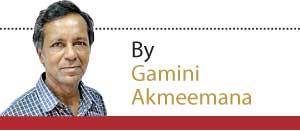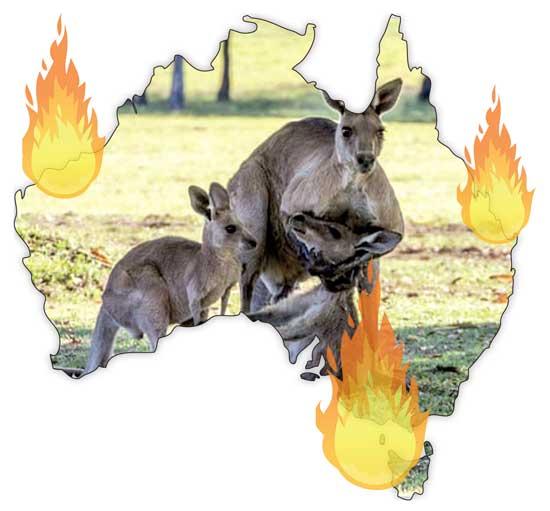Reply To:
Name - Reply Comment

While Sri Lankan media are feasting on the vicarious hobby of actor-turned politician Ranjan Ramanayake, a country that many Lankans dream of as a haven and their new home is burning.
When are we going to wake up to climate change? Though we have had deluges of rain in the past months instead of forest fires, city streets start burning from the sun’s heat the moment rains cease.
As Elizabeth Kolbert, Pulitzer Prize winning author of “The Sixth Extinction: An Unnatural History” puts it, the flip side of drought is deluge. While Australia was burning, flooding in Indonesia killed at least 40 people.
She gives us some sobering facts. In 2019, the world finally began to understand that climate change is more dangerous than the Cold War. The latter was about the potential for nuclear annihilation, while climate change is already killing people, animals and other species. In the past ten years, more Co2 was emitted than in all of human history till 1960.
Global Co2 emissions are now so high that, unless emissions are drastically reduced, a rise in temperature of 2 degrees Celsius (3.6 degrees Fahrenheit) is almost certain by 2030. This will destroy the world’s coral reefs, flood many low-lying island nations, cause relentless heat waves and fires. The effects of all this on millions – perhaps billions – of people can only be imagined.
 Incredibly, leaders of some of the world’s most powerful countries have been slow to react, and some even continue to deny climate change. In 2015 in Paris, Barack Obama and other world leaders pledged to hold average global temperature increase to ‘well below 2 degrees Celsius.’ But there was no agreement on how to do this. Now, the fragile climate control diplomacy is almost at breaking point. The two major culprits are the US and Australia. The Trump administration filed to withdraw the US from the Paris Agreement, while Australia’s Scott Morrison government tried to use an accounting trick to fulfill its Paris commitments.
Incredibly, leaders of some of the world’s most powerful countries have been slow to react, and some even continue to deny climate change. In 2015 in Paris, Barack Obama and other world leaders pledged to hold average global temperature increase to ‘well below 2 degrees Celsius.’ But there was no agreement on how to do this. Now, the fragile climate control diplomacy is almost at breaking point. The two major culprits are the US and Australia. The Trump administration filed to withdraw the US from the Paris Agreement, while Australia’s Scott Morrison government tried to use an accounting trick to fulfill its Paris commitments.
They have emitted 250 million tonnes of Co2, almost half the country’s annual emissions. Australia ranked worst among 57 countries on climate policy. Conservative Prime Minister Scott Morrison, who went on vacation as the fires raged, has downplayed the catastrophe. Last week, the government ordered 10,000 camels to be shot because they drink too much water. A camel drinks 53 gallons of water (200 litres) in three minutes. But it can go without water for a week after this.
A new washing machine uses 15-30 gallons of water per load while older ones use 29-45 gallons. In Australia, a shower consumes 20 litres of water per minute. A water-efficient shower (anywhere in the world) uses about 9 litres of water per minute. A 5-minute daily shower uses about 36,500 litres of water per year. But showers and washing machines are used by voters. No government will want to ask a voter to manage with a 5-minute shower or less. Camels do not vote and cannot protest.
But the annihilation of many smaller species by fire has not even been recorded. The bush fires have destroyed about 5.8 million hectares of bush. Ecologists say the fires have pushed back conservation efforts by decades. As climate heating takes effect, some species may never recover.
The Kangaroo Island dunnart, Koalas, greater gliders, wombats, the mountain pygmy possum, the Hastings river mouse and the critically endangered long-footed potorooc are among those badly affected species, while three quarters of threatened species happen to be plants.
"Global Co2 emissions are now so high that, unless emissions are drastically reduced, a rise in temperature of 2 degrees Celsius (3.6 degrees Fahrenheit) is almost certain by 2030"
In Southern Queensland, much of the known range of the silver-headed antechinus has been destroyed by fires.
Prof. Richard Kingsford, Director of the University of New South Wales Centre for Ecosystem Science, said the fires would rob many bird species of vital old-growth trees they need to breed. Fire had taken away the invertebrate bugs the birds feed on, and that food source would not return until there was significant rain.
According to an article published in the Guardian UK newspaper, Prof. Sarah Legge of the Australian National University said that prospects for the Kangaroo Island dunnart was not good, and its plight was symbolic of what was happening all across the east coast of Australia.
Though conservationists were working tirelessly to rescue surviving animals, and the New South Wales National Parks and Wildlife Service recently initiated food drops for starving brush-trailed rock wallabies, the task ahead looks herculean. New South Wales Environment Minister Matt Kean said those animals which escaped fires are now without food.
He’s the only leading Australian politician to publicly acknowledge the truth about climate change, and was attacked for it by the Daily Telegraph on its front page. Australia’s main media company is owned by Rupert Murdoch, and its editors and leading columnists all take a very conservative line on the issue of climate change.
Greg Jericho, who writes on economics for Guardian Australia, wrote “it will require a political party able to persuade voters it needs to happen, because the low-hanging fruits of climate change reduction have all been picked.
Jericho further said that the Labour Party too, has distanced itself from the climate change movement. While 20,000 people took spontaneously to the streets in Sydney, protesting the government’s complacency, Labour leader Anthony Albanese, with his own electorate ravaged by bush fires, chose to visit coalmines and aluminum smelters in rural Queensland to discuss “practical” solutions.
Jericho emphasizes that “any political party that wishes to actually do real action will at some point need to be honest with the public that the change is not going to be pleasant; for many it will be costly…we are for a start going to need to keep coal in the ground – even our glorious cleaner-than-others coal.”
Finally, when are we here in Sri Lanka going to wake up to climate change? Are we going to wait till our forests catch fire or till our coastal areas are flooded?